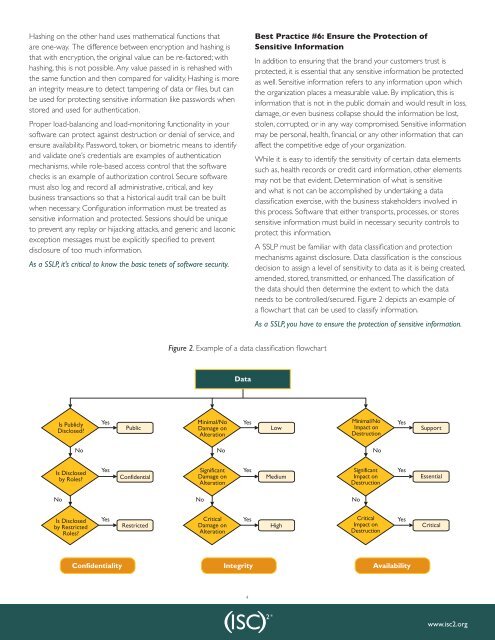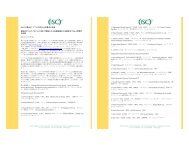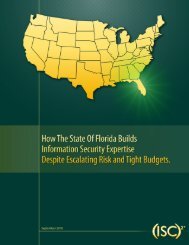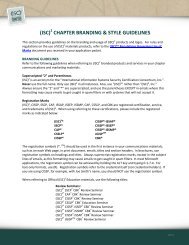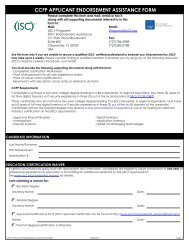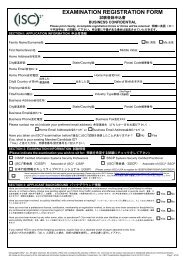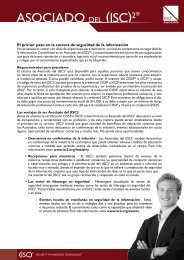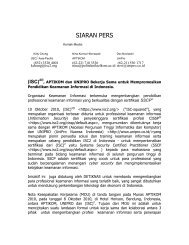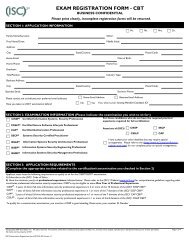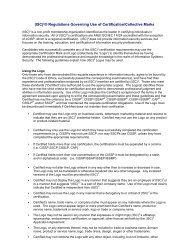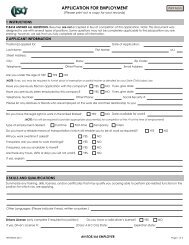The Ten Best Practices for Secure Software Development - ISC
The Ten Best Practices for Secure Software Development - ISC
The Ten Best Practices for Secure Software Development - ISC
You also want an ePaper? Increase the reach of your titles
YUMPU automatically turns print PDFs into web optimized ePapers that Google loves.
Hashing on the other hand uses mathematical functions that<br />
are one-way. <strong>The</strong> difference between encryption and hashing is<br />
that with encryption, the original value can be re-factored; with<br />
hashing, this is not possible. Any value passed in is rehashed with<br />
the same function and then compared <strong>for</strong> validity. Hashing is more<br />
an integrity measure to detect tampering of data or files, but can<br />
be used <strong>for</strong> protecting sensitive in<strong>for</strong>mation like passwords when<br />
stored and used <strong>for</strong> authentication.<br />
Proper load-balancing and load-monitoring functionality in your<br />
software can protect against destruction or denial of service, and<br />
ensure availability. Password, token, or biometric means to identify<br />
and validate one’s credentials are examples of authentication<br />
mechanisms, while role-based access control that the software<br />
checks is an example of authorization control. <strong>Secure</strong> software<br />
must also log and record all administrative, critical, and key<br />
business transactions so that a historical audit trail can be built<br />
when necessary. Configuration in<strong>for</strong>mation must be treated as<br />
sensitive in<strong>for</strong>mation and protected. Sessions should be unique<br />
to prevent any replay or hijacking attacks, and generic and laconic<br />
exception messages must be explicitly specified to prevent<br />
disclosure of too much in<strong>for</strong>mation.<br />
As a SSLP, it’s critical to know the basic tenets of software security.<br />
Is Publicly<br />
Disclosed?<br />
Is Disclosed<br />
by Roles?<br />
No<br />
No<br />
Is Disclosed<br />
by Restricted<br />
Roles?<br />
Yes<br />
Yes<br />
Yes<br />
4<br />
<strong>Best</strong> Practice #6: Ensure the Protection of<br />
Sensitive In<strong>for</strong>mation<br />
In addition to ensuring that the brand your customers trust is<br />
protected, it is essential that any sensitive in<strong>for</strong>mation be protected<br />
as well. Sensitive in<strong>for</strong>mation refers to any in<strong>for</strong>mation upon which<br />
the organization places a measurable value. By implication, this is<br />
in<strong>for</strong>mation that is not in the public domain and would result in loss,<br />
damage, or even business collapse should the in<strong>for</strong>mation be lost,<br />
stolen, corrupted, or in any way compromised. Sensitive in<strong>for</strong>mation<br />
may be personal, health, financial, or any other in<strong>for</strong>mation that can<br />
affect the competitive edge of your organization.<br />
While it is easy to identify the sensitivity of certain data elements<br />
such as, health records or credit card in<strong>for</strong>mation, other elements<br />
may not be that evident. Determination of what is sensitive<br />
and what is not can be accomplished by undertaking a data<br />
classification exercise, with the business stakeholders involved in<br />
this process. <strong>Software</strong> that either transports, processes, or stores<br />
sensitive in<strong>for</strong>mation must build in necessary security controls to<br />
protect this in<strong>for</strong>mation.<br />
A SSLP must be familiar with data classification and protection<br />
mechanisms against disclosure. Data classification is the conscious<br />
decision to assign a level of sensitivity to data as it is being created,<br />
amended, stored, transmitted, or enhanced. <strong>The</strong> classification of<br />
the data should then determine the extent to which the data<br />
needs to be controlled/secured. Figure 2 depicts an example of<br />
a flowchart that can be used to classify in<strong>for</strong>mation.<br />
As a SSLP, you have to ensure the protection of sensitive in<strong>for</strong>mation.<br />
Minimal/No Yes<br />
Minimal/No Yes<br />
Public Damage on<br />
Low Impact on<br />
Support<br />
Alteration<br />
Destruction<br />
Confidential<br />
Restricted<br />
Figure 2. Example of a data classification flowchart<br />
Significant<br />
Damage on<br />
Alteration<br />
No<br />
No<br />
Critical<br />
Damage on<br />
Alteration<br />
Data<br />
Yes<br />
Yes<br />
Medium<br />
High<br />
Significant<br />
Impact on<br />
Destruction<br />
No<br />
No<br />
Critical<br />
Impact on<br />
Destruction<br />
Confidentiality Integrity Availability<br />
Yes<br />
Yes<br />
Essential<br />
Critical<br />
www.isc2.org


